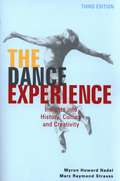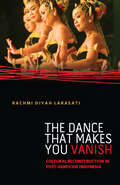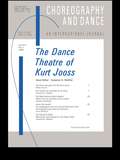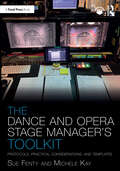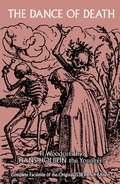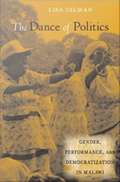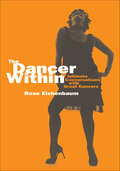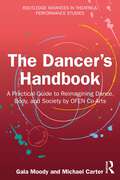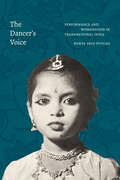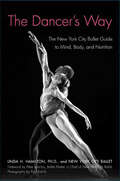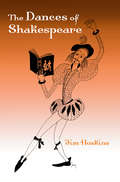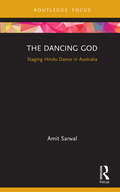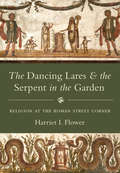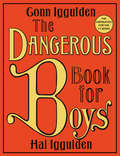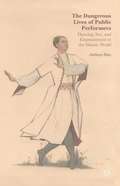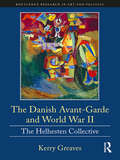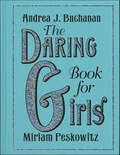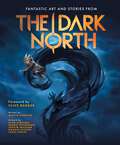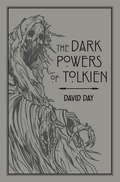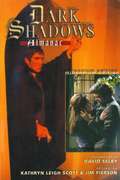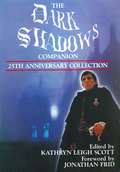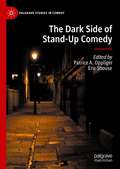- Table View
- List View
The Dance Experience: Insights into History, Culture, and Creativity (3rd Edition)
by Myron Howard Nadel Marc Raymond StraussProviding an understanding of the history, evolution, and universality of dance as an art form, this guidebook explores the significance of dance in culture, the relationship of dance to other art forms, the contributions of great pioneering choreographers, dancers, and teachers, and the creative process. Highlighting an extensive range of types of dance—including ballet, modern, jazz, tap, folk, ethnic, and social—this comprehensive collection features a variety of engaging essays written by experts in their respective fields. Students of dance, professionals, instructors, and enthusiasts will learn what to look for during a performance, and how to appreciate dance styles from around the world. This newly revised edition includes five new chapters and an extensive, annotated appendix of film resources giving helpful suggestions for viewing that will enhance the dance experience.
The Dance That Makes You Vanish: Cultural Reconstruction in Post-Genocide Indonesia (Difference Incorporated)
by Rachmi Diyah LarasatiIndonesian court dance, a purportedly pure and untouched tradition, is famed throughout the world for its sublime calm and stillness. Yet this unyieldingly peaceful surface conceals a time of political repression and mass killing. Between 1965 and 1966, some one million Indonesians—including a large percentage of the country&’s musicians, artists, and dancers—were killed, arrested, or disappeared as Suharto established a virtual dictatorship that ruled for the next thirty years. In The Dance That Makes You Vanish, an examination of the relationship between female dancers and the Indonesian state since 1965, Rachmi Diyah Larasati elucidates the Suharto regime&’s dual-edged strategy: persecuting and killing performers perceived as communist or left leaning while simultaneously producing and deploying &“replicas&”—new bodies trained to standardize and unify the &“unruly&” movements and voices of those vanished—as idealized representatives of Indonesia&’s cultural elegance and composure in bowing to autocratic rule. Analyzing this history, Larasati shows how the Suharto regime&’s obsessive attempts to control and harness Indonesian dance for its own political ends have functioned as both smoke screen and smoke signal, inadvertently drawing attention to the site of state violence and criminality by constantly pointing out the &“perfection&” of the mask that covers it.Reflecting on her own experiences as an Indonesian national troupe dancer from a family of persecuted female dancers and activists, Larasati brings to life a powerful, multifaceted investigation of the pervasive use of culture as a vehicle for state repression and the global mass-marketing of national identity.
The Dance Theatre of Kurt Jooss
by Suzanne WaltherFirst Published in 1997. Routledge is an imprint of Taylor & Francis, an informa company.
The Dance and Opera Stage Manager's Toolkit: Protocols, Practical Considerations, and Templates (The Focal Press Toolkit Series)
by Susan Fenty Studham Michele KayThe Dance and Opera Stage Manager’s Toolkit details unique perspectives and approaches to support stage managers beginning to navigate the fields of dance and opera stage management in live performance.This book demystifies the genre-specific protocols and vocabularies for stage managers who might be unfamiliar with these fields and discusses common practices. Filled with valuable industry-tested tools, templates, and practical information, The Dance and Opera Stage Manager’s Toolkit is designed to assist stage managers interested in pursuing these performance genres. The book also includes interviews and contributions from a range of professional stage managers working in dance and opera.From the student stage manager studying in Theatrical Design and Production university programs to the experienced stage manager wanting to broaden their skill set, this book provides resources and advice for a successful transition into these worlds.The Dance and Opera Stage Manager’s Toolkit includes access to an online repository of resources and paperwork examples to help jumpstart the reader’s journey into dance and opera stage management. To access these resources, visit www.routledge.com/9780367566579.
The Dance of Death
by Hans HolbeinHans Holbein the Younger (1497-1543), remembered today for his insightful portraits, was better known in his own time for his varied and extensive graphic works, the most celebrated of which was The Dance of Death. This work, from the woodblocks of collaborator Hans Lützelburger, was first published in book form in 1538.The theme of the dance of death was a popular one of the sixteenth century. Holbein captured the feeling of death, the leveler, in its attack on all classes, both sexes, and all ages. A stylized skeleton seizes the child from his mother's breast. The skeleton snatches, plays, tugs, and cavorts throughout the rest of the book. The king, emperor, pope, and cardinal must cease from their functions. The skull is thrust into the face of the astrologer. The hourglass runs out onto the floor. Countess, nun, sailor, peddler, senator are all stopped by the common force. Forty-one finely cut, highly detailed woodcuts capture the single motif, Memento mori: "Remember, you will die." Although the theme is common, the variety of expressions, social groups, backgrounds, styles of dress and architecture, and calls to death are so varied that each one is unique in its power.This edition, reprinting the unabridged 1538 edition, is the first in a series reprinting great rare books from the Rosenwald Collection. Besides the woodcuts, the book contains a prefatory letter by Jean de Vauzéle and various quotations, depictions, and meditations on death, deaths of men, and the necessity of death. A repeated series of the 41 woodblocks follows the reprinted work and contains English translations of the quotations and verses. Art historians and social historians will find this to be one of the best depictions of class life caught at its fateful moment. The collector will find this to be the finest reproduction of one of Holbein's major works.
The Dance of Death: Exhibited In Elegant Engravings On Wood With A Dissertation On The Several Representations Of That Subject But More Particularly
by Hans HolbeinA new departure in Penguin Classics: a book containing one of the greatest of all Renaissance woodcut sequences - Holbein's bravura danse macabreOne of Holbein's first great triumphs, The Dance of Death is an incomparable sequence of tiny woodcuts showing the folly of human greed and pride, with each image packed with drama, wit and horror as a skeleton mocks and terrifies everyone from the emperor to a ploughman. Taking full advantage of the new literary culture of the early 16th century, The Dance of Death took an old medieval theme and made it new.This edition of The Dance of Death reproduces a complete set from the British Museum, with many details highlighted and examples of other works in this grisly field. Ulinka Rublack introduces the woodcuts with a remarkable essay on the late medieval danse macabre and the world Holbein lived in.
The Dance of Politics: Gender, Performance, and Democratization in Malawi
by Lisa GilmanElection campaigns, political events, and national celebration days in Malawi usually feature groups of women who dance and perform songs of praise for politicians and political parties. These lively performances help to attract and energize throngs of prospective voters. <p><p> However, as Lisa Gilman explains, “praise performing” is one of the only ways that women are allowed to participate in a male-dominated political system. Although political performances by women are not unique to Malawi, the case in Malawi is complicated by the fact that until 1994 allMalawianwomen were required to perform on behalf of the long-reigning political party and its self-declared “President for Life,” Dr. Hastings Kamuzu Banda+. <p> This is the first book to examine the present-day situation, where issues of gender, economics and politics collide in surprising ways. Along with its solid grounding in the relevant literature, The Dance of Politics draws strength from Gilman’s first-hand observations and her interviews with a range of participants in the political process, from dancers to politicians.
The Dance of Reality: A Psychomagical Autobiography
by Alejandro JodorowskyA glimpse into the mind and life of one of the most creative and enigmatic visionaries of our time, filmmaker Alejandro Jodorowsky • Retraces the spiritual and mystical path Jodorowsky has followed since childhood, vividly repainting events from the perspective of an unleashed imagination • Explores the development of the author’s psychomagic and metagenealogy practices via his realization that all problems are rooted in the family tree • Includes photos from Jodorowsky’s appearance at the 2013 Cannes Film Festival and from the film based on this book, which debuted at Cannes Retracing the spiritual and mystical path he has followed since childhood, Alejandro Jodorowsky re-creates the incredible adventure of his life as an artist, filmmaker, writer, and therapist--all stages on his quest to push back the boundaries of both imagination and reason. Not a traditional autobiography composed of a chronological recounting of memories, The Dance of Reality repaints events from Jodorowsky’s life from the perspective of an unleashed imagination. Like the psychomagic and metagenealogy therapies he created, this autobiography exposes the mythic models and family templates upon which the events of everyday life are founded. It reveals the development of Jodorowsky’s realization that all problems are rooted in the family tree and explains, through vivid examples from his own life, particularly interactions with his father and mother, how the individual’s road to true fulfillment means casting off the phantoms projected by parents on their children. The Dance of Reality is autobiography as an act of healing. Through the retelling of his own life, the author shows we do not start off with our own personalities, they are given to us by one or more members of our family tree. To be born into a family, Jodorowsky says, is to be possessed. To peer back into our past is equivalent to digging into our own souls. If we can dig deep enough, beyond familial projections, we shall find an inner light--a light that can help us through life’s most difficult tests. Offering a glimpse into the mind and life of one of the most creative and enigmatic visionaries of our time, The Dance of Reality is the book upon which Jodorowsky’s critically acclaimed 2013 Cannes Film Festival film of the same name was based.
The Dancer Within: Intimate Conversations with Great Dancers
by Rose EichenbaumThe Dancer Within is a collection of photographic portraits and short essays based on confessional interviews with forty dancers and entertainers, many of them world-famous. Well-known on the concert stage, on Broadway, in Hollywood musicals, and on television, the personalities featured in this book speak with extraordinary candor about all stages of the dancer's life—from their first dance class to their signature performances and their days of reflection on the artist's life. The Dancer Within reveals how these artists triumphed, but also how they overcame adversity, including self-doubt, injuries, and aging. Most of all, this book is about the courage, commitment, love, and passion of these performers in their quest for artistic excellence. The reader will quickly realize that "the dancer within" is a metaphor of the human spirit.
The Dancer's Handbook: A Practical Guide to Reimagining Dance, Body, and Society by OFEN Co-Arts (Routledge Advances in Theatre & Performance Studies)
by Michael Carter Gala MoodyThe Dancer’s Handbook offers a holistic exploration of the dance industry's challenges, authored by dancers intimately familiar with its complexities.This comprehensive resource tackles themes like power dynamics, hierarchical structures, and the pervasive influences of capitalism, patriarchy, and white supremacy as the “status quo” in the arts. This book delves into dismantling the status quo, examining its manifestations in the body and mind of dancers, and advocates for wellbeing and self-worth in the workplace as the way of change. Psychological aspects, coping mechanisms, and the importance of rest are addressed alongside discussions on ethical engagement, consent, and the democratisation of workplace behaviour through co-authored principles of practice. The final chapters empower dancers to find their voice, offering structured communication strategies to confront transgressive behaviours and foster accountability.With insights from years of reimagining working conditions, this book serves as a beacon for positive change, urging dancers and dance-related professionals to challenge norms, prioritise wellbeing, and speak up to power.
The Dancer's Voice: Performance and Womanhood in Transnational India
by Rumya Sree PutchaIn The Dancer’s Voice Rumya Sree Putcha theorizes how the Indian classical dancer performs the complex dynamics of transnational Indian womanhood. Putcha argues that the public persona of the Indian dancer has come to represent India in the global imagination—a representation that supports caste hierarchies and Hindu ethnonationalism, as well as white supremacist model minority narratives. Generations of Indian women have been encouraged to embody the archetype of the dancer, popularized through film cultures from the 1930s to the present. Through analyses of films, immigration and marriage laws, histories of caste and race, advertising campaigns, and her own family’s heirlooms, photographs, and memories, Putcha reveals how women’s citizenship is based on separating their voices from their bodies. In listening closely to and for the dancer’s voice, she offers a new way to understand the intersections of body, voice, performance, caste, race, gender, and nation.
The Dancer's Way: The New York City Ballet Guide to Mind, Body, and Nutrition
by Linda H. Hamilton New York City BalletIn the current dance scene, performers contend with choreography that involves extreme dance, multiple techniques, and acrobatic moves, exemplified in the popular reality television show, "So You Think You Can Dance." The dilemma for aspiring professionals is that dance class no longer provides sufficient preparation for performing at this level. Dancers who want to achieve their best, avoid injury, and perform at their peak will welcome the insight and advice in the pages of The Dancer's Way. The world-renowned New York City Ballet developed their proven wellness program to help dancers reach their potential without compromising their health. As one of the key designers of this program, former dancer and clinical psychologist Linda Hamilton, Ph.D. provides the essential principles of wellness that will help you achieve your goals in all levels and forms of dance. These include keeping yourself physically healthy, nutritionally sound, and mentally prepared as a dancer. New York City Ballet's celebrated program, here for the first time in book form, highlights every tool you'll need to stay in great shape.
The Dances of Shakespeare
by Jim HoskinsFirst Published in 2005. Routledge is an imprint of Taylor & Francis, an informa company.
The Dancing God: Staging Hindu Dance in Australia
by Amit SarwalThe Dancing God: Staging Hindu Dance in Australia charts the sensational and historic journey of de-provincialising and popularising Hindu dance in Australia. In the late nineteenth and early twentieth centuries, colonialism, orientalism and nationalism came together in various combinations to make traditional Hindu temple dance into a global art form. The intricately symbolic Hindu dance in its vital form was virtually unseen and unknown in Australia until an Australian impresario, Louise Lightfoot, brought it onto the stage. Her experimental changes, which modernised Kathakali dance through her pioneering collaboration with Indian dancer Ananda Shivaram, moved the Hindu dance from the sphere of ritualistic practice to formalised stage art. Amit Sarwal argues that this movement enabled both the authentic Hindu dance and dancer to gain recognition worldwide and created in his persona a cultural guru and ambassador on the global stage. Ideal for anyone with an interest in global dance, The Dancing God is an in-depth study of how a unique dance form evolved in the meeting of travellers and cultures.
The Dancing Lares and the Serpent in the Garden: Religion at the Roman Street Corner
by Harriet I. FlowerThe most pervasive gods in ancient Rome had no traditional mythology attached to them, nor was their worship organized by elites. Throughout the Roman world, neighborhood street corners, farm boundaries, and household hearths featured small shrines to the beloved lares, a pair of cheerful little dancing gods. These shrines were maintained primarily by ordinary Romans, and often by slaves and freedmen, for whom the lares cult provided a unique public leadership role. In this comprehensive and richly illustrated book, the first to focus on the lares, Harriet Flower offers a strikingly original account of these gods and a new way of understanding the lived experience of everyday Roman religion.Weaving together a wide range of evidence, Flower sets forth a new interpretation of the much-disputed nature of the lares. She makes the case that they are not spirits of the dead, as many have argued, but rather benevolent protectors—gods of place, especially the household and the neighborhood, and of travel. She examines the rituals honoring the lares, their cult sites, and their iconography, as well as the meaning of the snakes often depicted alongside lares in paintings of gardens. She also looks at Compitalia, a popular midwinter neighborhood festival in honor of the lares, and describes how its politics played a key role in Rome’s increasing violence in the 60s and 50s BC, as well as in the efforts of Augustus to reach out to ordinary people living in the city’s local neighborhoods.A reconsideration of seemingly humble gods that were central to the religious world of the Romans, this is also the first major account of the full range of lares worship in the homes, neighborhoods, and temples of ancient Rome.Some images inside the book are unavailable due to digital copyright restrictions.
The Dangerous Book for Boys: Things To Do
by Conn Iggulden Hal IgguldenThe bestselling book—more than 1.5 million copies sold—for every boy from eight to eighty, covering essential boyhood skills such as building tree houses, learning how to fish, finding true north, and even answering the age old question of what the big deal with girls is—is soon to be an Amazon Prime Original Series created by Bryan Cranston (Breaking Bad) and Greg Mottola (Superbad).The classic bestselling book for every boy from eight to eighty, covering essential boyhood skills such as building tree houses*, learning how to fish, finding true north, and even answering the age-old question of what the big deal with girls is.In this digital age, there is still a place for knots, skimming stones and stories of incredible courage. This book recaptures Sunday afternoons, stimulates curiosity, and makes for great father-son activities. The brothers Conn and Hal have put together a wonderful collection of all things that make being young or young at heart fun—building go-carts and electromagnets, identifying insects and spiders, and flying the world's best paper airplanes.Skills covered include: The Greatest Paper Airplane in the WorldThe Seven Wonders of the Ancient WorldThe Five Knots Every Boy Should KnowStickballSlingshotsFossilsBuilding a Treehouse*Making a Bow and ArrowFishing (revised with US Fish)Timers and TripwiresBaseball's "Most Valuable Players"Famous Battles-Including Lexington and Concord, The Alamo, and Gettysburg Spies-Codes and CiphersMaking a Go-CartNavajo Code Talkers' DictionaryGirlsCloud FormationsThe States of the U.S. Mountains of the U.S.NavigationThe Declaration of Independence Skimming StonesMaking a PeriscopeThe Ten CommandmentsCommon US TreesTimeline of American History
The Dangerous Lives of Public Performers
by Anthony ShayExamining performers from the ancient Mediterranean world to the modern Islamic Middle East, including India and Pakistan, Shay explores the careers, artistic performances, and legacies of these individuals who were forced to produce entertainment and art for, and have sex with, any and all patrons.
The Danish Avant-Garde and World War II: The Helhesten Collective (Routledge Research in Art and Politics)
by Kerry GreavesThis is the first book to focus on Helhesten (The Hell-Horse), an avant-garde artists’ collective active during the Nazi occupation of Denmark and one of the few tangible connections between radical European art groups from the 1920s to the 1960s. The Danes’ deliberately unskilled painterly abstraction, embrace of the tradition of dansk folkelighed (the popular) and its iterations of egalitarianism and consensus reform, called for the political relevance of art and interrogated the ideologies underlying culture itself. The group’s cultural activism presents an alternative trajectory of continuity, which challenges the customary view of World War II as a moment of artistic rupture.
The Daring Book for Girls
by Andrea J. Buchanan Miriam PeskowitzThe Daring Book for Girls is the manual for everything that girls need to know—and that doesn't mean sewing buttonholes! Whether it's female heroes in history, secret note-passing skills, science projects, friendship bracelets, double dutch, cats cradle, the perfect cartwheel or the eternal mystery of what boys are thinking, this book has it all. But it's not just a guide to giggling at sleepovers—although that's included, of course! Whether readers consider themselves tomboys, girly-girls, or a little bit of both, this book is every girl's invitation to adventure.
The Dark North
by Martin DunelindOriginally crowd funded for publication in 2015, this illustrated prose-art book fusion features five unique tales ranging from Norse mythology to apocalyptic science fiction to fantasy. The Dark North showcases artwork by Scandinavia's leading illustrators and concept artists--including Peter Bergting, Henrik Pettersson, Joakim Ericsson, Magnus Olsson, and Lukas Thelin--and is written by Martin Duneland. With a foreword by author and filmmaker Clive Barker, this anthology is sure to delight--and terrify--any horror fan in equal measure.
The Dark Powers of Tolkien: An illustrated Exploration of Tolkien's Portrayal of Evil, and the Sources that Inspired his Work from Myth, Literature and History (Tolkien)
by David DayJ.R.R. Tolkien's The Lord of the Rings, The Hobbit and The Silmarillion are some of the greatest tales of good versus evil ever told. From the creation of Arda to the War of the Ring, Tolkien's Middle-earth has seen war and rebellion, devastation and loss, in which the powers of darkness emerged. Here in his latest book, best-selling author and Tolkien expert David Day explores Tolkien's portrayal of evil, and the sources that inspired his work: from myth, literature and history. This work is unofficial and is not authorized by the Tolkien Estate or HarperCollins Publishers.
The Dark Shadows Almanac
by Kathryn Leigh Scott Jim Pierson David SelbyTHE DARK SHADOWS ALMANAC: Millenium Edition is a colorful, picture-packed tribute to the legendary 1966 - 1971 Gothic ABC-TV daytime series Dark Shadows, that starred Jonathan Frid as vampire Barnabas Collins. THE DARK SHADOWS ALMANAC was originally published in 1995 to celebrate the 30th anniversary of the show every kid "ran home from school to watch,"The Millenium Edition has been updated, and contains 16 pages of additional text and photographs. Edited by series archivist Jim Pierson and Dark Shadows actress Kathryn Leigh Scott (Maggie Evans and Josette duPrés), this book overflows with fascinating facts, anecdotes and trivia about Dark Shadows, along with dozens of never-before-published photographs. THE DARK SHADOWS ALMANAC: Millenium Edition includes a Foreword by actor David Selby, who played Quentin Collins on the series. Lara Parker, who portrayed Angelique, has written a sparkling salute to the fans, who have kept the series alive and airing continuously for three decades. Associate Producer George DiCenzo and Scenic Designer Sy Tomashoff also provide fascinating, often hilarious behind-the-scenes insights as to how the show was conceived and produced. Other contributors include Louis Edmonds, Marie Wallace, Donna Wandrey, Dennis Patrick and Dark Shadows fans themselves, who recount their youthful, unforgettable experiences visiting the Manhattan TV studio while the series was in production. Additional features of THE DARK SHADOWS ALMANAC: Millenium Edition are a complete list of cast and characters, program history, storyline and production details, and a tribute to Dark Shadows creator and executive producer Dan Curtis. THE DARK SHADOWS ALMANAC: Millenium Edition is the fourth in a series of Dark Shadows volumes published by Pomegranate Press. In 1986, the company issued Kathryn Leigh Scott's My Scrapbook Memories of Dark Shadows, followed by The Dark Shadows Companion in 1990. Dark Shadows Resurrected, devoted to the 1991 revival series, was published in 1992.
The Dark Shadows Companion
by Kathryn Leigh Scott Jonathan FridThe timeless magic of the Gothic cult series Dark Shadows comes alive in Kathryn Leigh Scott's Dark Shadows Companion, as members of the original cast of Dark Shadows reunite to recall great moments and personal memories of this enduring classic. With a Foreword by Jonathan Frid (vampire Barnabas Collins), this Silver Anniversary treasure trove features rare color and black & white photographs, a complete history of the original Dark Shadows series, including a synopsis of all 1,225 episodes.
The Dark Side of Stand-Up Comedy (Palgrave Studies in Comedy)
by Patrice A. Oppliger Eric ShouseThis book focuses on the “dark side” of stand-up comedy, initially inspired by speculations surrounding the death of comedian Robin Williams. Contributors, those who study humor as well as those who perform comedy, join together to contemplate the paradoxical relationship between tragedy and comedy and expose over-generalizations about comic performers’ troubled childhoods, addictions, and mental illnesses. The book is divided into two sections. First, scholars from a variety of disciplines explore comedians’ onstage performances, their offstage lives, and the relationship between the two. The second half of the book focuses on amateur and lesser-known professional comedians who reveal the struggles they face as they attempt to hone successful comedy acts and likable comic personae. The goal of this collection is to move beyond the hackneyed stereotype of the sad clown in order to reveal how stand-up comedy can transform both personal and collective tragedies by providing catharsis through humor.
